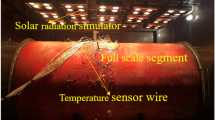Abstract
Solar radiation developing non-linear temperature distribution at the depth of the concrete structures may cause significant stress changes along the long span box type bridges. Segmental concrete box bridges are one of the example in which stresses change not only due to annual uniform temperature changes but also due to daily temperature changes that can develop a second type of thermal difference; namely, thermal gradient, which forces to have internal thermal stresses within a cross-section. Over the years it has been observed that nonlinear temperature distribution develop at the depth of box girder type bridges can cause bending moments as high as the ones generated due to live loads that may result in concrete cracking. American Highway Association of Transportation Officials (AASHTO) bridge specifications recognize the use of thermal gradient loads in design since 1989. In this specification, the U.S. is divided into 4 zones per the country’s solar radiation zones and gives some gradient values to be applied through the depth of the girder. The aim of this study is to construct a simple similar solar radiation map for Turkey to be used in design of segmental bridges. Temperature and solar radiation data from eight cities in different regions of Turkey are collected, and used in analysis of a box girder bridge model through a thermal finite element analysis program. Thermal differences through the depth of the girder are determined to obtain the design gradient values for the bridge that can be hypothetically constructed in different parts of Turkey. The end results are used to develop a recommendation for a simple solar map that is related to thermal gradients to be used in design of segmental bridges.
Access this chapter
Tax calculation will be finalised at checkout
Purchases are for personal use only
Similar content being viewed by others
References
AASHTO (1998a) AASHTO LRFD bridge design specifications. Washington, D.C
AASHTO (1989a) Guide specifications for design and construction of segmental bridges. American Association of State Highway and Transportation Officials, Washington, D.C
AASHTO (1999) Guide specifications for design and construction of segmental bridges. American Association of State Highway and Transportation Officials, Washington, D.C
AASHTO (1989b) Guide specifications: thermal effects in concrete bridge superstructures. American Association of State Highway and Transportation Officials, Washington, D.C
AASHTO (1994b) Interim specifications for the guide specifications for design and construction of segmental bridges. American Association of State Highway and Transportation Officials, Washington, D.C
AASHTO (2012) LRFD bridge design specifications. Customary U.S. Units, Washington, D.C
AASHTO (1989c) Standard specifications for highway bridges. American Association of State Highway and Transportation Officials, Washington, D.C
Aksoy B (2011) Solar radiation over Turkey and its analysis. Int J Remote Sens
Albostan U (2013) Implementation of coupled thermal and structural analysis methods for reinforced concrete structures. Middle East Technical University
ASHRAE (2001) The American Society of Heating, Refrigerating and Air-Conditioning Engineers Handbook
British Standard BS 5400 (1978) Steel, concrete and composite bridges, part I, general statement. British Standards Institution, Crowthorne, Berkshire
Deutsche Norman DIN 1072 (1967) Strassen and WegbrUcken (Street and road bridges), II Ber1 in and Koln
Hoffman PC, McClure RM, West HH (1980) Temperature studies for an experimental bridge, research project 75-3 Interim report. Pennsylvania State University
Imbsen RA, Vandershof DE, Schamber RA, Nutt RV (1985) Thermal effects in concrete bridge superstructures, NCHRP 276. Transportation Research Board, Washington D.C
Lee JH (2012) Investigation of extreme environmental conditions and design thermal gradients during construction for prestressed concrete bridge girders. J Bridge Eng ASCE
Lee JH, Kalkan I (2012) Analysis of thermal environmental effects on precast, prestressed concrete bridge girders: temperature differentials and thermal deformations. Adv Struct Eng 15(3)
Leonhardt F, Kolbe G, Peter J (1965) Temperaturunterschiede gefahrden spannbetonbrilcke (Temperature differences endanger prestressed concrete bridges), 11 Beton und Stahlbetonbau 60(7):231–244
National Aeronautics And Space Administration (NASA) (2014) Surface meteorology and solar energy. Available online at http://eosweb.larc.nasa.gov/
National Renewable Energy Laboratory (NREL) (1994) Solar radiation data manual for flat-plate and concentrating collectors, Golden, CO
Post-Tensioning Institute (PTI) (1997) Precast segmental box girder bridge manual. Post-Tensioning Institute and Precast/Prestressed Concrete Institute
Potgieter IC, Gamble WL (1983) Response of highway bridges to nonlinear temperature distributions. Structural research series no. 505. University of Illinois at Urbana-Champaign, Illinois
Priestley MJN (1987) Design of concrete bridges for temperature gradients. ACI J 75(5):209–217
Roberts CL (1993) Measurement based revisions for segmental bridge design and construction criteria. The University of Texas at Austin, Austin
Shushkewich KW (1998) Design of segmental bridges for thermal gradient. PCI J 43(4):120–137
Wood BA (2007) Thermal gradients and their effects on segmental concrete box girder bridges. University of Texas at Austin
Author information
Authors and Affiliations
Corresponding author
Editor information
Editors and Affiliations
Rights and permissions
Copyright information
© 2016 Springer International Publishing Switzerland
About this chapter
Cite this chapter
Yilmaz, A.I., Albostan, U., Caner, A., Kurc, O. (2016). Turkish Solar Radiation Zones for Segmental Box Girder Bridge Design Under Temperature Gradient Loading. In: Caner, A., Gülkan, P., Mahmoud, K. (eds) Developments in International Bridge Engineering. Springer Tracts on Transportation and Traffic, vol 9. Springer, Cham. https://doi.org/10.1007/978-3-319-19785-2_7
Download citation
DOI: https://doi.org/10.1007/978-3-319-19785-2_7
Published:
Publisher Name: Springer, Cham
Print ISBN: 978-3-319-19784-5
Online ISBN: 978-3-319-19785-2
eBook Packages: EngineeringEngineering (R0)



